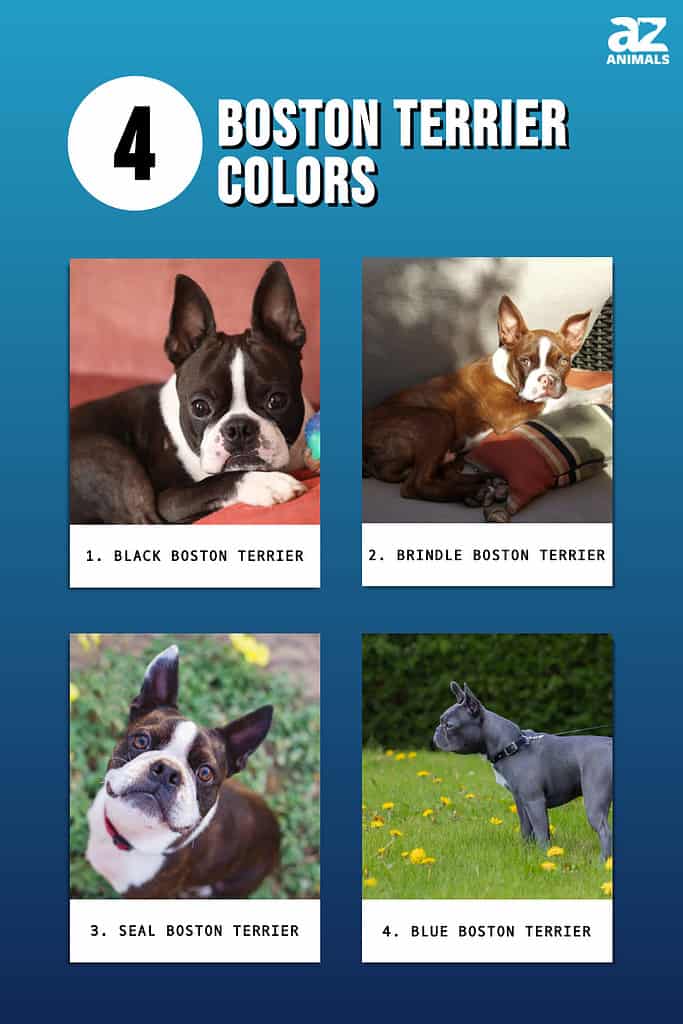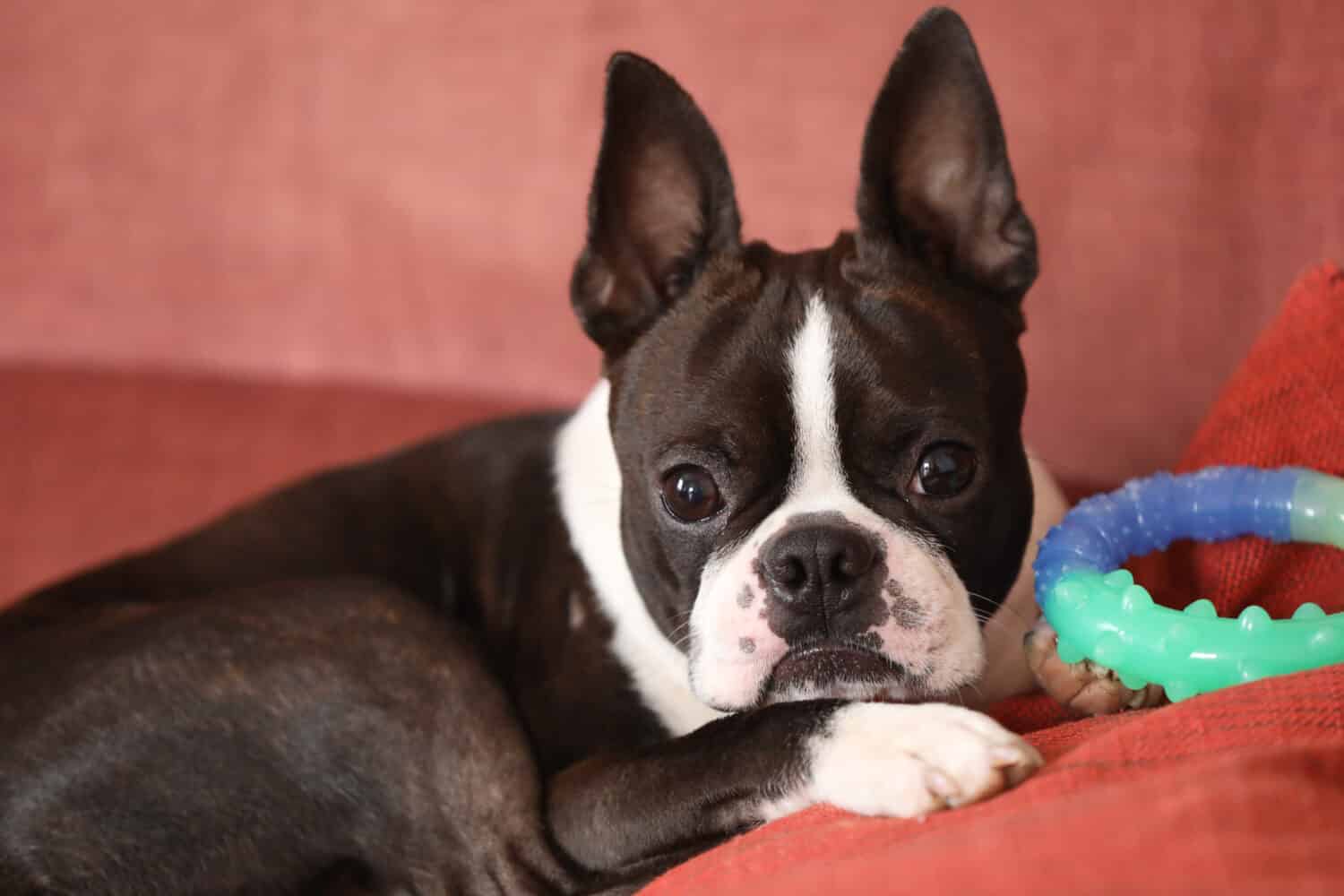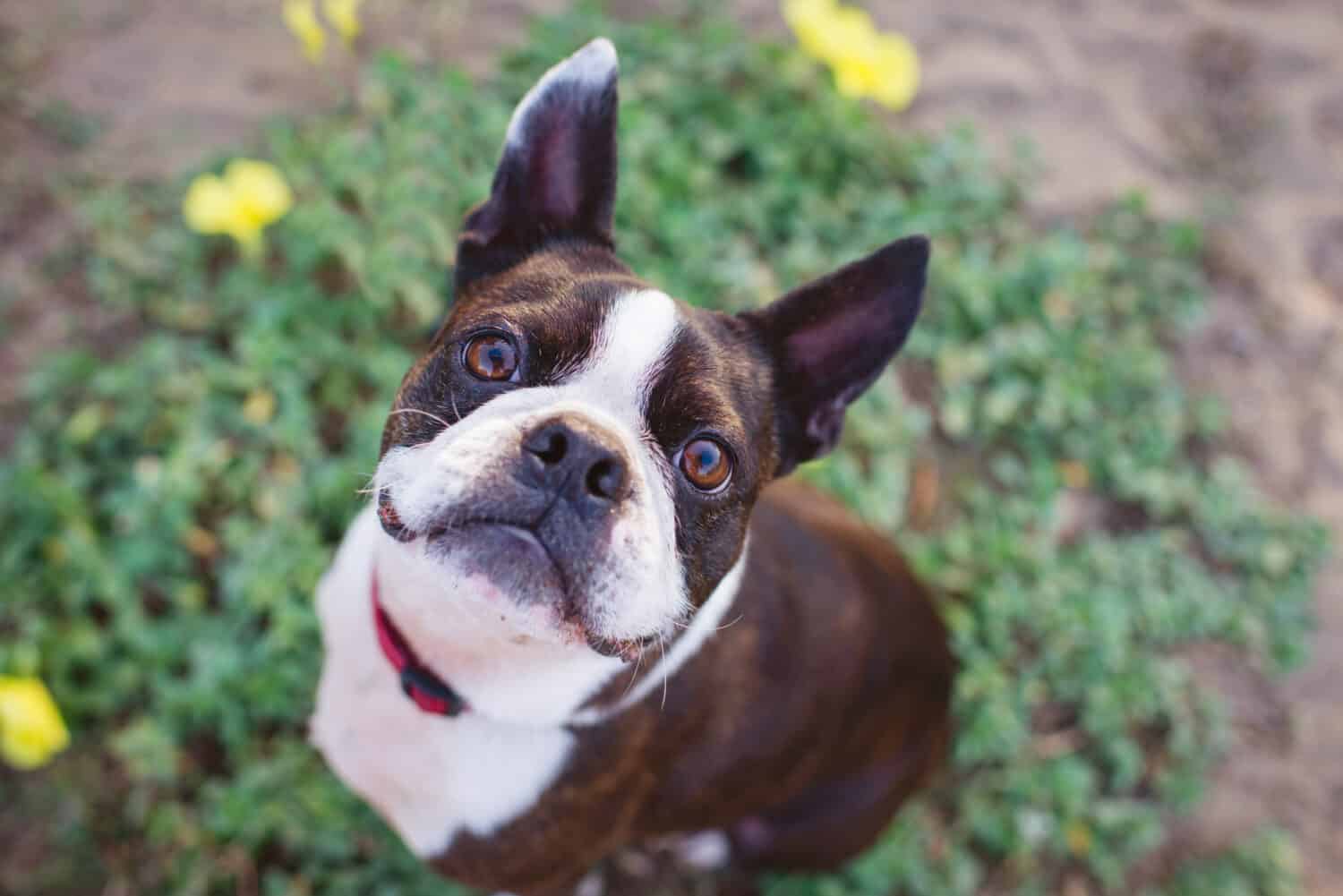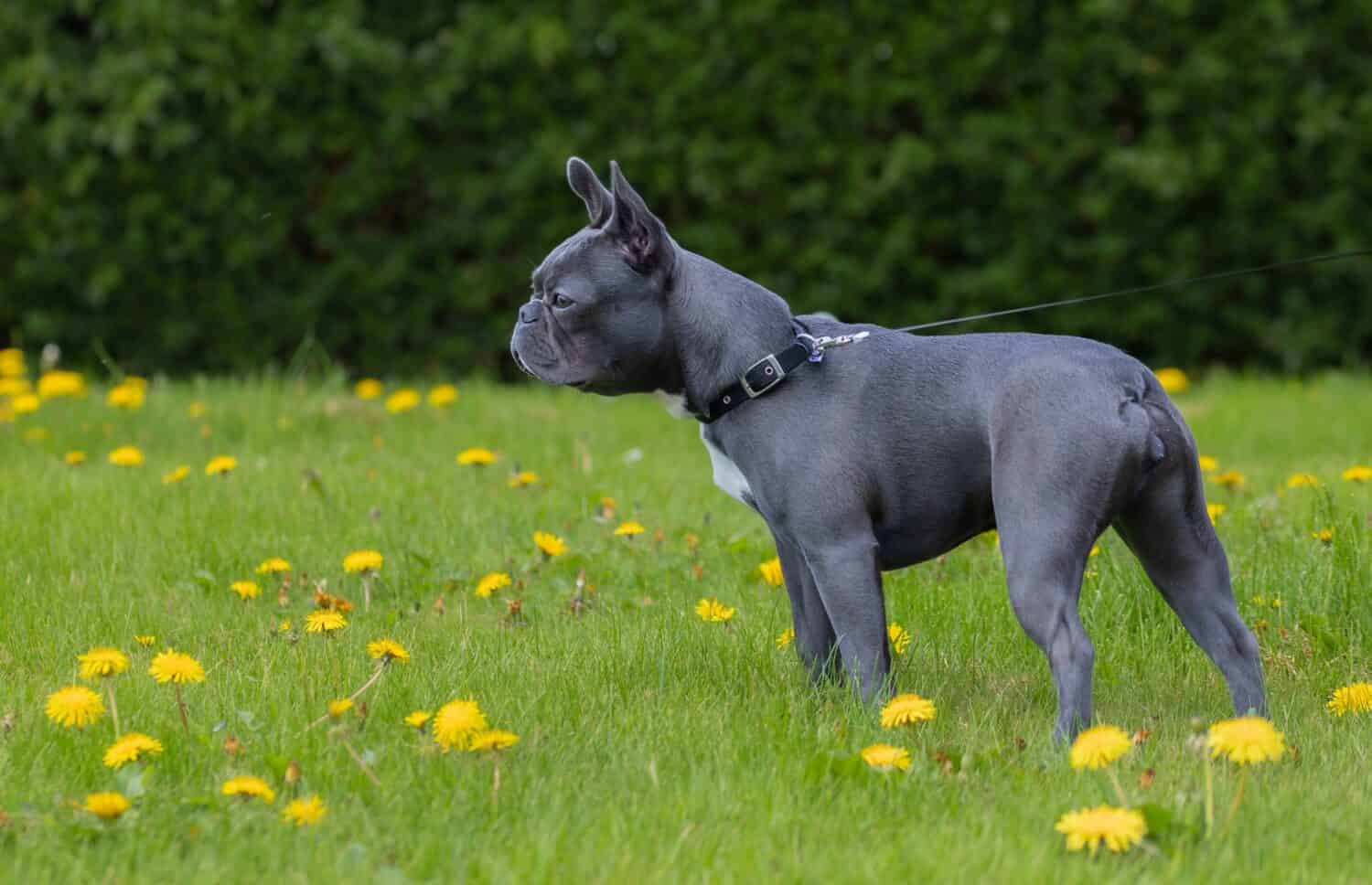A beloved dog around the world, the Boston terrier has gained the nickname “American Gentleman” over many years. However, this is not due to having manners or acting human, but rather because their colorful coats often resemble a tuxedo worn for a special occasion. Furthermore, these dogs are fun-loving and goofy, the perfect addition to any family.

Many people think that most Boston terriers are black, but they come in a variety of colors depending on their lineage. These include a seal color that looks black, but if the light hits just right, you can see red tones filtering through. Interestingly, the color of a Boston terrier can even affect its health. Lastly, The American Kennel Club (AKC) only recognizes Boston terriers that are brindle, black, and seal with white markings around their muzzle, along their chest, and between their eyes.

Many people think that most Boston terriers are black, but they come in a variety of colors depending on their lineage.
©Zero Degrees Photography/Shutterstock.com
1. Black Boston Terrier (Black and White)
The aptly known black Boston terrier is the most common. In addition, they may have white markings, usually around the mouth, eyes, and chest.

This black Boston terrier has white markings around its neck, chest, snout, and paws.
©es.photo/Shutterstock.com
2. Brindle Boston Terrier
The brindle Boston terrier has what is known as “tiger-striping.” This is because it has a brindle pattern on its back instead of black. However, many of them have white markings around the mouth, eyes, and chest.

This Brindle Boston terrier has white markings on its neck, chest, head, snout, and paws.
©Mark Stephen Spiteri/Shutterstock.com
3. Seal Boston Terrier

Seal Boston terriers can have white markings on their chests, necks, heads, snouts, and paws.
Image: Kellymmiller73, Shutterstock
©Kellymmiller73/Shutterstock.com
These Boston terriers look almost black. However, if they appear in the correct light, they have a red or copper tinge. They can also have white markings like the other colors.
4. Other Boston Terrier Colors
Many Boston terriers have a combination of colors; for instance, seal with white or brindle with white. However, Boston terriers are found in a few rare colors, including chocolate brown, red, and blue.
The chocolate brown Boston terrier can be light or dark brown and may or may not have white markings. Sometimes they are referred to as liver-colored. Many people enjoy this color as it doesn’t look dirty as easily as some other colors.
Boston terriers also come in red. However, not many come in this vibrant color. They could be reddish-brown, orange, or multi-colored with shades of brown and red.
Blue Boston terriers don’t really look blue; rather, they appear silver or gray. These are some of the rarest Boston terrier colors, and many believe that the “blue” color comes from poor breeding practices over time. Even so, they are very popular among families and households all over the world.

Blue Boston terriers can have a touch of white on their chest.
©Rob Blaze/Shutterstock.com
History of the Boston Terrier
Boston terriers came into existence in the 1800s in Boston, Massachusetts. However, there are many different stories about how the breed came to exist. The first story is that the coachmen of a wealthy family crossed bulldogs and the now-extinct English White terrier to create a new dog-fighting breed. Another story is that a Bostonian named Robert C. Hooper imported a bulldog/English terrier from England because the dog reminded him of a beloved childhood dog. The dog was named Judge, and another rumor was that Hooper bought him from another Bostonian. Judge was a well-built dog weighing 32 pounds and was dark brindle with white markings on his face.
Judge was only bred once with a dog named Burnett’s Gyp (or Kate), who belonged to Edward Burnet. The pair only had one male puppy named Well’s Eph, who was not an attractive dog. However, he did have other characteristics which Hooper’s friends admired. This led to Well’s Eph being widely bred. One of his mates was a female named Tobin’s Kate. This little female weighed only 20 pounds and had short hair. She was golden brindle, and their offspring were bred with French bulldogs to create the Boston terrier as we know it today. However, they were not known as Boston terriers. Instead, they had many names, including round-headed bull-and-terrier, American terrier, bullet heads, and Boston bulldogs. Later they became known as Boston Bulls. However, in 1979 the Boston terrier became the official dog of Massachusetts.
Size
The lovely Boston terrier occurs in 3 weight classes, namely 20 to 25 pounds, 15 to 19 pounds, and under 15 pounds. They normally reach a height of between 12 to 17 inches. Additionally, they are stocky and should never look skinny or spindly.
Personality
As previously stated, these dogs are known as American gentlemen and are smart, lively, affectionate, gentle, and even-tempered. However, they can be stubborn, and therefore training is imperative. In addition, they need early socialization with other dogs and exposure to sounds, sights, and people.
Health
Boston terriers are generally healthy dogs, but like all breeds, they may be prone to certain health issues. Not all Boston terriers will get all or any of these health conditions, but finding a good breeder is important.
Some of the Health Issues that Boston Terriers May Experience Include:
Cherry Eye
This is the prolapse of the 3rd eyelid, and researchers believe pups inherit this disease from their parents. It commonly occurs in dogs that are under one year old. Veterinarians can remove the gland altogether or surgically reposition it to its natural site at the base of the third eyelid.
Cataracts
A cloudy film over the lens of the eye. This issue can occur with young or old Boston terriers. Furthermore, it occurs between the ages of 8 weeks and 12 months in young dogs. Therefore, it is possible to see cataracts in young dogs. However, sometimes they can only be picked up by a CERF (Canine Eye Registration Foundation) test.
Heart Murmurs
A defect that causes a backflow of blood into the heart’s left atrium. As a result, a soft or loud sound can be heard, especially over the mitral valve area. Therefore, the heart cannot provide enough blood to the rest of the body. Luckily, this can be treated with medication, a low-sodium diet, diuretics, and exercise restrictions.
Deafness
These dogs have a high chance of being or becoming deaf in one or both ears. Boston terriers who are white over one-third of their bodies have a much higher chance of producing deaf offspring.
Patellar Luxation
This is a common issue in small dogs and is sometimes referred to as “slipped stifles.” It occurs when the patella, which is made up of 3 parts, the tibia (calf), the patella (kneecap), and the femur (thigh bone), are not properly lined up. This can result in limping or lameness. Unfortunately, this issue is present at birth, yet symptoms can lay dormant for a long time. There are different grades of patellar luxation ranging from mild to severe. Furthermore, the treatments can range from medication to surgery.
Megaesophagus
This is a condition where the structure of the esophagus is defective and causes the dog to regurgitate its undigested food.
Reverse Sneezing
This issue happens when the dog gets too excited and nasal secretions drop onto its soft palate, causing it to close over the windpipe. Mostly this occurs when the dog gulps their food, but pollen in the air can also cause this health issue. Usually, stroking their throat will help.
Allergies
Boston terriers may suffer from different allergies, such as food allergies. Signs include licking the paws or rubbing the face constantly. Vets can diagnose and treat these allergies with a special diet or medication.
Summary of Boston Terrier Colors: Rarest to Most Common
| Rank | Color |
|---|---|
| 1 | Black Boston Terrier (Black and White) |
| 2 | Brindle Boston Terrier |
| 3 | Seal Boston Terrier |
| 4 | Other Rare Colors: chocolate brown, red, and blue |
The photo featured at the top of this post is © Lenka_N/Shutterstock.com
Ready to discover the top 10 cutest dog breeds in the entire world?
How about the fastest dogs, the largest dogs and those that are -- quite frankly -- just the kindest dogs on the planet? Each day, AZ Animals sends out lists just like this to our thousands of email subscribers. And the best part? It's FREE. Join today by entering your email below.
Thank you for reading! Have some feedback for us? Contact the AZ Animals editorial team.






